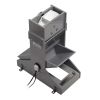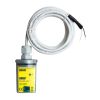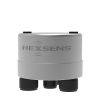KISTERS Single Tipping Bucket Flow Gauges
Features
- Bucket tip volume set at 0.5L or 1L per tip
- Maximum flow rate of 25 liters per minute
- Includes 24VDC dual reed switch
- Expedited repair and warranty service
- Lifetime technical support
- More
Overview
The KISTERS single tipping bucket flow gauges TB0.5L and TB1L are used for measuring water seepage coming out of a pipe or a drain. In both models, the bucket is connected to its own dual reed switch, effectively enabling redundant data acquisition in two distinct data loggers, or providing data to two devices (e.g. a data logger and a counting display), etc.
Design
TB0.5L and TB1L are perfectly suitable for flow measurements in water-carrying sediments or iron hydroxide deposition. Made of plastics and coated steel, these devices are both robust, fast and easy to clean.
Mechanics
The bucket tips when it is filled to maximum. The magnet integrated into the bucket rearside slides along the reed switch mounted in the flow gauge’s frame. The magnetic field forces a contact closure in the reed switch. The latter can be recorded by one or two connected data loggers. The number of tips per time unit is a measure of the flow rate.
| Material | PVC plastic and stainless steel | ||||||||||||||||
| Resolutions | PVC bucket: 0.5 L or 1.0 L (selectable), up to 25 L/minute | ||||||||||||||||
| Accuracy |
|
||||||||||||||||
| Signal Out |
|
||||||||||||||||
| Flow Rate | Maximum 25 L/minute | ||||||||||||||||
| Level | Bulls eye level adhered to stainless steel base | ||||||||||||||||
| Environmental Conditions |
|
||||||||||||||||
| Dimensions & Mass |
|
In The News
Supplying Seattle’s Drinking Water: Using Data Buoys to Monitor the Cedar River Municipal Watershed
Providing clean, safe, and reliable drinking water for the 1.6 million people in the greater Seattle area is a top priority for Seattle Public Utilities (SPU). With limited water supplies, SPU dedicates considerable resources to maintain its watersheds and mountain reservoirs. About 70 percent of Seattle Water comes from the Cedar River Municipal Watershed , and the other 30 percent comes from the South Fork Tolt River Watershed . [caption id="attachment_39574" align="alignnone" width="940"] Data buoy in Chester Morse Lake . (Credit: Kevin Johnson / Seattle Public Utilities) [/caption] Jamie Thompson, a fisheries biologist at SPU, monitors aquatic ecosystems centered on fish listed under the U.S. Endangered Species Act (ESA).
Read MoreData-Driven Advocacy on the Lower Deschutes River
Like many freshwater environments, the Deschutes River in Oregon is under pressure from development, pollution, and climate change. Many rivers, streams and lakes in the Deschutes Basin do not meet Oregon water quality standards –where state water quality monitoring assesses levels of bacteria, pH, dissolved oxygen, temperature, and fine sediment. Hannah Camel is the Water Quality Coordinator for the Deschutes River Alliance (DRA), a non-profit organization that focuses on the health of the lower 100 miles of the Deschutes River–the area most affected by human intervention. As a data-driven organization, the DRA has benefited from the installation of two NexSens X2 data loggers.
Read MoreExpanding the Port Everglades: Real-Time Monitoring of Water Quality Conditions from Planned Dredging Operation
The Port Everglades in Broward County, Florida, serves large trade vessels and cruiseliners and incoming and outgoing recreational boaters. However, as cargo ships become larger, the port must expand. A dredging project led by the US Army Corps of Engineers will substantially deepen and widen the port's navigation channel to accommodate larger Panamax cargo ships and modern cruise liners. As a result of this project, a large amount of sediment will be displaced into the water column. This suspended sediment may settle outside of the project area, burying benthic organisms like corals, and possibly carrying harmful particulates to other regions. [caption id="attachment_39497" align="aligncenter" width="2560"] A CB-950 and CB-25 deployed on site at Port Everglades.
Read More










